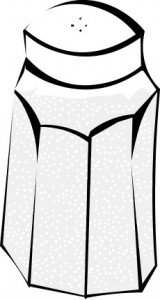How Much Do You Know About Salt?
 1. True or false: “I don’t use the salt shaker all that much which means I don’t eat too much sodium.”2. True or false: “Sea salt is healthy because it is a natural salt?”3. True or false: “Most people need to eat more salt in their diet; more is always better, right?”4. True or false: “You don’t have to worry about salt intake unless you have high blood pressure.”5. “Blood pressure rises naturally with age.”Answers:1. False. Unless you are preparing all of your meals from scratch, including the bread, pasta sauce, salad dressing and crackers you are eating, you are likely consuming at least double the amount of sodium recommended. In modern Westernized societies only about 10% of dietary salt comes naturally from the foods consumed. Another 15-25% comes from the salt shaker and about 75% of the salt in the typical Western diet comes from processed foods and meals consumed away from the home.2. False. Sea salt, Kosher salt and other designer and colored salts contain the same amount of sodium as table salt. Table salt is 40% sodium and 60%?chloride by weight. 1 teaspoon of salt is about 2,400 mg of sodium.3. False. The average American consumes about 3,000 to 5,000 mg (130-217 mmol) of sodium per day or about 7.5 to 12.5 grams of salt daily. We need sodium in our diet to be alive, but very little, about 500 mg per day is sufficient. The Dietary Guidelines for Americans call for 1,500 for individuals who have or who are at risk for high blood pressure and no more than 2,000 mg for everyone else. Most people need to cut their sodium levels by two or three times!4. False. Why worry? Because an overwhelming amount of research shows that a high sodium take leads to hypertension, stroke, kidney disease.5. False. Research indicates that blood pressure does not rise with age in cultures that do not add salt to their food.How do I lower my sodium intake?1) Be aware of the sodium content of restaurant meals by using online nutrition data. Specify items without added salt or sauce; use vinegar instead of salad dressing; choose steamed vegetables and salads more often.2) Read the Nutrition Facts Label of foods you purchase in the store so you become aware of the sodium content of foods you eat. If a food has 5% or less of the daily value for sodium it is low in sodium.3) Switch to low-sodium foods and seasonings. Plain rice and pasta, fresh fruits and vegetables, fresh poultry, meat and fish and canned items without added salt are your best bet.
1. True or false: “I don’t use the salt shaker all that much which means I don’t eat too much sodium.”2. True or false: “Sea salt is healthy because it is a natural salt?”3. True or false: “Most people need to eat more salt in their diet; more is always better, right?”4. True or false: “You don’t have to worry about salt intake unless you have high blood pressure.”5. “Blood pressure rises naturally with age.”Answers:1. False. Unless you are preparing all of your meals from scratch, including the bread, pasta sauce, salad dressing and crackers you are eating, you are likely consuming at least double the amount of sodium recommended. In modern Westernized societies only about 10% of dietary salt comes naturally from the foods consumed. Another 15-25% comes from the salt shaker and about 75% of the salt in the typical Western diet comes from processed foods and meals consumed away from the home.2. False. Sea salt, Kosher salt and other designer and colored salts contain the same amount of sodium as table salt. Table salt is 40% sodium and 60%?chloride by weight. 1 teaspoon of salt is about 2,400 mg of sodium.3. False. The average American consumes about 3,000 to 5,000 mg (130-217 mmol) of sodium per day or about 7.5 to 12.5 grams of salt daily. We need sodium in our diet to be alive, but very little, about 500 mg per day is sufficient. The Dietary Guidelines for Americans call for 1,500 for individuals who have or who are at risk for high blood pressure and no more than 2,000 mg for everyone else. Most people need to cut their sodium levels by two or three times!4. False. Why worry? Because an overwhelming amount of research shows that a high sodium take leads to hypertension, stroke, kidney disease.5. False. Research indicates that blood pressure does not rise with age in cultures that do not add salt to their food.How do I lower my sodium intake?1) Be aware of the sodium content of restaurant meals by using online nutrition data. Specify items without added salt or sauce; use vinegar instead of salad dressing; choose steamed vegetables and salads more often.2) Read the Nutrition Facts Label of foods you purchase in the store so you become aware of the sodium content of foods you eat. If a food has 5% or less of the daily value for sodium it is low in sodium.3) Switch to low-sodium foods and seasonings. Plain rice and pasta, fresh fruits and vegetables, fresh poultry, meat and fish and canned items without added salt are your best bet.